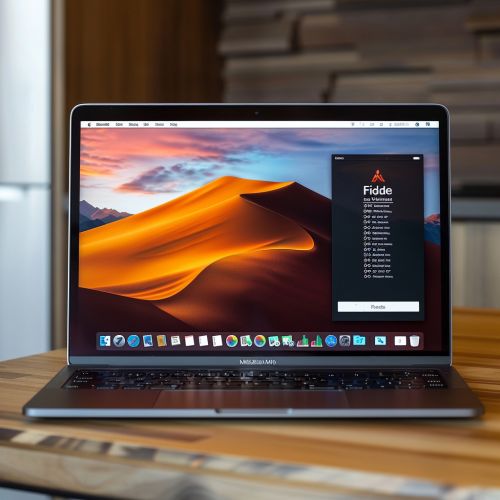FileVault: Difference between revisions
(Created page with "== Overview == <div class='only_on_desktop image-preview'><div class='image-preview-loader'></div></div><div class='only_on_mobile image-preview'><div class='image-preview-loader'></div></div> FileVault is a disk encryption program available in macOS, Apple's operating system for Macintosh computers. It uses the user's login password as the encryption passphrase and employs the XTS-AES-128 encryption algorithm with a 256-bit key to help prevent unauthorized access to i...") |
No edit summary |
||
| Line 1: | Line 1: | ||
== Overview == | == Overview == | ||
[[Image:Detail-79581.jpg|thumb|center|A MacBook laptop displaying the FileVault encryption settings screen.]] | |||
FileVault is a disk encryption program available in macOS, Apple's operating system for Macintosh computers. It uses the user's login password as the encryption passphrase and employs the XTS-AES-128 encryption algorithm with a 256-bit key to help prevent unauthorized access to information on the startup disk. FileVault was first introduced in Mac OS X 10.3 Panther and has undergone significant enhancements in subsequent versions of macOS. | FileVault is a disk encryption program available in macOS, Apple's operating system for Macintosh computers. It uses the user's login password as the encryption passphrase and employs the XTS-AES-128 encryption algorithm with a 256-bit key to help prevent unauthorized access to information on the startup disk. FileVault was first introduced in Mac OS X 10.3 Panther and has undergone significant enhancements in subsequent versions of macOS. | ||
Revision as of 01:34, 19 May 2024
Overview

FileVault is a disk encryption program available in macOS, Apple's operating system for Macintosh computers. It uses the user's login password as the encryption passphrase and employs the XTS-AES-128 encryption algorithm with a 256-bit key to help prevent unauthorized access to information on the startup disk. FileVault was first introduced in Mac OS X 10.3 Panther and has undergone significant enhancements in subsequent versions of macOS.
History and Development
FileVault was initially released in 2003 with Mac OS X 10.3 Panther. The first version, now referred to as FileVault 1, encrypted the user's home directory using the AES-128 algorithm. This approach had limitations, such as performance overhead and the inability to encrypt the entire disk.
With the release of Mac OS X 10.7 Lion in 2011, Apple introduced FileVault 2. This version brought full-disk encryption, which addressed many of the limitations of the original FileVault. FileVault 2 uses XTS-AES-128 encryption, providing stronger security and better performance.
Technical Architecture
Encryption Algorithm
FileVault 2 employs the XTS-AES-128 encryption algorithm with a 256-bit key. The XTS mode (XEX-based Tweaked CodeBook mode with ciphertext stealing) is designed specifically for disk encryption and provides enhanced security over other modes like CBC (Cipher Block Chaining). XTS-AES-128 ensures that each block of data is encrypted uniquely, even if the same plaintext appears in multiple locations on the disk.
Key Management
FileVault uses the user's login password to derive the encryption key. This process involves a key derivation function (KDF) that transforms the password into a cryptographic key. The derived key is then used to encrypt and decrypt the disk. Additionally, FileVault supports the use of a recovery key, which can be used to unlock the disk if the user forgets their password. The recovery key is a randomly generated 24-character string that should be stored in a secure location.
Secure Enclave
On Macs equipped with the T2 Security Chip, the Secure Enclave coprocessor enhances the security of FileVault. The Secure Enclave manages the encryption keys and performs cryptographic operations, ensuring that the keys are never exposed to the main processor or memory. This hardware-based security feature provides an additional layer of protection against attacks.
Implementation and Usage
Enabling FileVault
To enable FileVault, users can navigate to the Security & Privacy pane in System Preferences and select the FileVault tab. The system will prompt the user to enter their login password and choose a recovery option. Once enabled, FileVault will begin encrypting the disk in the background. The encryption process can take several hours, depending on the size of the disk and the amount of data stored.
Performance Impact
FileVault 2 is designed to minimize performance impact. The encryption and decryption processes are performed on-the-fly, meaning that data is encrypted as it is written to the disk and decrypted as it is read. On modern Macs, especially those with the T2 Security Chip, the performance overhead is negligible. However, older systems may experience some slowdown during disk-intensive operations.
Compatibility and Limitations
FileVault is compatible with macOS 10.7 Lion and later. It supports both HFS+ and APFS file systems. However, certain features, such as Time Machine backups and Boot Camp, have specific requirements and limitations when used with FileVault. For example, Time Machine backups can be encrypted separately, and Boot Camp partitions cannot be encrypted with FileVault.
Security Considerations
Threat Model
FileVault is designed to protect against unauthorized access to data on a lost or stolen Mac. It ensures that even if the physical disk is removed and connected to another system, the data remains inaccessible without the encryption key. However, FileVault does not protect against attacks that occur while the system is running and the disk is unlocked.
Vulnerabilities and Mitigations
While FileVault provides robust security, it is not immune to vulnerabilities. For instance, cold boot attacks can potentially recover encryption keys from a system's memory if it is not properly powered down. To mitigate such risks, users should enable the "Require password after sleep or screen saver begins" option and shut down their Mac when not in use.
Another potential vulnerability is the use of weak passwords. Users should choose strong, unique passwords and consider using a password manager to generate and store them securely.
Future Developments
Apple continues to enhance FileVault with each new release of macOS. Future developments may include improvements in encryption algorithms, key management, and integration with other security features. Additionally, as hardware advancements are made, FileVault's performance and security are expected to improve further.
